
Installation art is an artistic genre of three-dimensional works that are often site-specific and designed to transform the perception of a space. Generally, the term is applied to interior spaces, whereas exterior interventions are often called public art, land art or art intervention; however, the boundaries between these terms overlap.

Land art, variously known as Earth art, environmental art, and Earthworks, is an art movement that emerged in the 1960s and 1970s, largely associated with Great Britain and the United States but that also includes examples from many countries. As a trend, "land art" expanded boundaries of art by the materials used and the siting of the works. The materials used were often the materials of the Earth, including the soil, rocks, vegetation, and water found on-site, and the sites of the works were often distant from population centers. Though sometimes fairly inaccessible, photo documentation was commonly brought back to the urban art gallery.

Sir Richard Julian Long, is an English sculptor and one of the best-known British land artists.
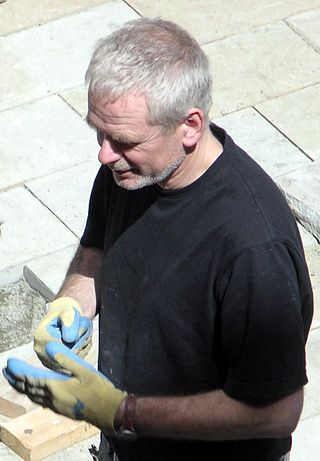
Andy Goldsworthy is an English sculptor, photographer, and environmentalist who produces site-specific sculptures and land art situated in natural and urban settings.
Spirit of place refers to the unique, distinctive and cherished aspects of a place; often those celebrated by artists and writers, but also those cherished in folk tales, festivals and celebrations. It is thus as much in the invisible weave of culture as it is the tangible physical aspects of a place or its interpersonal aspects.
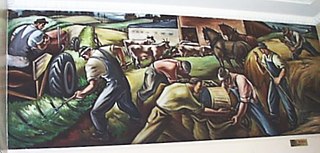
The Northwest School was an American art movement established in the Seattle area. It flourished in the 1930s–40s.

Environmental art is a range of artistic practices encompassing both historical approaches to nature in art and more recent ecological and politically motivated types of works. Environmental art has evolved away from formal concerns, for example monumental earthworks using earth as a sculptural material, towards a deeper relationship to systems, processes and phenomena in relationship to social concerns. Integrated social and ecological approaches developed as an ethical, restorative stance emerged in the 1990s. Over the past ten years environmental art has become a focal point of exhibitions around the world as the social and cultural aspects of climate change come to the forefront.
Roxy Paine is an American painter and sculptor widely known for his installations that often convey elements of conflict between the natural world and the artificial plains man creates. He was educated at both the College of Santa Fe in New Mexico and the Pratt Institute in New York.
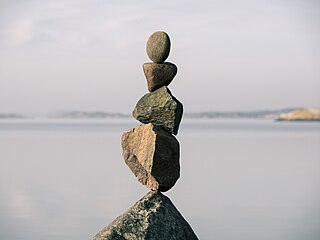
Rock balancing is a form of recreation or artistic expression in which rocks are piled in balanced stacks, often in a precarious manner.

Chris Drury is a British environmental artist. His body of work includes ephemeral assemblies of natural materials, land art in the mode associated with Andy Goldsworthy, as well as more permanent landscape art, works on paper and indoor installations. He also works in 3D (three-dimensional) sculpture.

Beacon Fell is a fell in the civil parish of Goosnargh in Lancashire, England. The high ground, which rises to 266 m (873 ft), has been a country park since 1970. It is situated within the south westerly part of the Forest of Bowland, an Area of Outstanding Natural Beauty.

Nils-Udo is a German artist from Bavaria who has been creating environmental art since the 1960s when he moved away from painting and the studio and began to work with, and in, nature. He began in the 1960s as a painter on traditional surfaces, in Paris, but moved to his home country in Bavaria and started to plant creations, putting them in Nature's hands to develop, and eventually disappear. As his work became more ephemeral, Udo introduced photography as part of his art to document and share it. Perhaps the best known example of his work for the general public is the cover design for Peter Gabriel's OVO. Nils-Udo seeks to offer a mutualist vision wherein nature as environment is an omnipresent backdrop. In revealing the diversity in a specific environment, he establishes links between human and natural history, between nature and humanity that are always there, yet seldom recognized. Nils-Udo uses natural materials, such as sticks, petals, branches, to create site-specific installations.

Roy Frank Staab is an American artist.
Steven Siegel is an American artist whose work includes public art, installation art, sculpture, collage and film. He is most known for site-specific, outdoor sculptures, public art commissions and installations made from repurposed pre- and postconsumer materials, which have been influenced by concepts and processes derived from geology and evolutionary biology. Writers relate his work in formal terms to minimalism, in its materials and emphasis on hands-on processes to postminimalism, and in its unconventional means to Land art.
Jason deCaires Taylor is a British sculptor and creator of the world's first underwater sculpture park – the Molinere Underwater Sculpture Park – and underwater museum – Cancún Underwater Museum (MUSA). He is best known for installing site-specific underwater sculptures that develop naturally into artificial coral reefs, which local communities and marine life depend on. Taylor integrates his skills as a sculptor, marine conservationist, underwater photographer and scuba diving instructor into each of his projects. By using a fusion of Land Art traditions and subtly integrating aspects of street art, Taylor produces dynamic sculptural works that are installed on the ocean floor to encourage marine life, to promote ocean conservation and to highlight the current climate crisis.
Actual Art is a genre of art that was first named by critic Alfred Frankenstein of the San Francisco Chronicle in a review of Helene Aylon’s work. The name was chosen because the art was "real", but the term realism was already in use. Frankenstein described Aylon's work as a genre of art that involves “the self-conscious enlistment of the forces of nature, by artists, toward the completion of their art”. Collaboration with nature necessarily brings the dimension of time into as an integral component of the artworks, with some requiring many thousands of years for their completion. The artists consider the future of the work to be as important as its present, relinquishing control over the work to nature.

Modern sculpture is generally considered to have begun with the work of Auguste Rodin, who is seen as the progenitor of modern sculpture. While Rodin did not set out to rebel against the past, he created a new way of building his works. He "dissolved the hard outline of contemporary Neo-Greek academicism, and thereby created a vital synthesis of opacity and transparency, volume and void". Along with a few other artists in the late 19th century who experimented with new artistic visions in sculpture like Edgar Degas and Paul Gauguin, Rodin invented a radical new approach in the creation of sculpture. Modern sculpture, along with all modern art, "arose as part of Western society's attempt to come to terms with the urban, industrial and secular society that emerged during the nineteenth century".
The Burnside Nest was a temporary outdoor sculpture by Swedish artist Hannes Wingate, installed in Portland, Oregon, United States, in 2014.
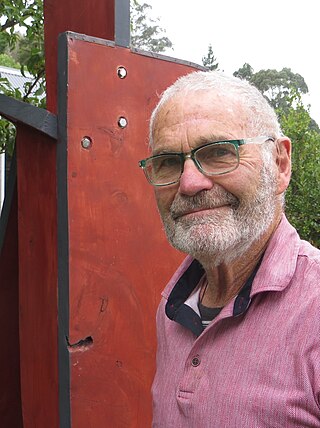
Peter Clement Fife Nicholls was a New Zealand artist who created large, outdoor works. His public art sculptures, often combining steel and native timbers, commented on the New Zealand landscape and its colonial history.
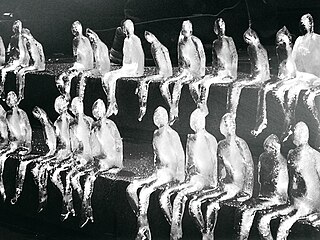
Ephemeral art is the name given to all artistic expression conceived under a concept of transience in time, of non-permanence as a material and conservable work of art. Because of its perishable and transitory nature, ephemeral art does not leave a lasting work, or if it does – as would be the case with fashion – it is no longer representative of the moment in which it was created. In these expressions, the criterion of social taste is decisive, which is what sets the trends, for which the work of the media is essential, as well as that of art criticism.













